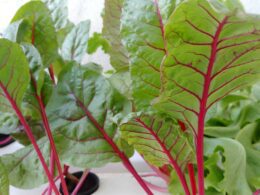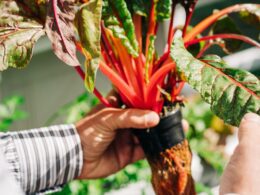Are you interested in growing your own lettuce but don’t have a lot of outdoor space or experience with gardening? Hydroponics may be the solution you’re looking for.
Hydroponic cultivation has become increasingly popular in recent years, and for good reason. It offers numerous advantages over traditional soil-based cultivation, including faster growth, higher yields, and reduced water usage.
If you’re wondering whether lettuce grows well in hydroponics, the answer is yes! In fact, lettuce is one of the most popular crops grown hydroponically. It’s relatively easy to cultivate, grows quickly, and has a high yield potential.
Plus, lettuce grown in hydroponics is often of higher quality than lettuce grown in soil, as it’s less prone to diseases and pests. In this article, we’ll explore the benefits of hydroponic cultivation, how to grow lettuce in hydroponics, common challenges you may encounter, and tips for ensuring success.
Advantages of Hydroponic Cultivation
You’ll be amazed at the benefits hydroponic cultivation has to offer! If you’re someone who’s interested in sustainable agriculture and maximizing food production, then hydroponics is the way to go.
One of the biggest advantages of hydroponic cultivation is that it allows for vertical farming. This means that you can grow more crops in a smaller space, making it perfect for those with limited land or space.
Another advantage of hydroponics is that it’s a more efficient and environmentally friendly way of growing crops. Since hydroponic systems use water as the main nutrient source, there’s no need for soil. This means that there’s less water waste and no soil erosion. Additionally, hydroponic systems use less water than traditional soil-based farming, making it a more sustainable option.
Lastly, hydroponic cultivation allows for more control over the growing conditions, which translates to better quality crops. With hydroponics, you can adjust the nutrient levels, pH balance, and lighting to create the perfect environment for your crops to thrive. This means that you can produce higher yields, higher quality crops, and even grow crops year-round.
Incorporating hydroponics into your farming practice is a smart choice for anyone who wants to maximize their food production while minimizing their environmental impact. With the benefits of vertical farming, sustainable agriculture, and a more controlled growing environment, hydroponics is the way to go for a more efficient and effective way of growing crops.
Growing Lettuce in Hydroponics
Growing fresh and vibrant greens has never been easier with indoor farming and sustainable agriculture. Hydroponic cultivation is an innovative technique that allows lettuce to grow well without soil. This method is becoming increasingly popular because it offers several advantages, such as faster growth, higher yields, and fewer pests.
In hydroponic cultivation, lettuce is grown in a nutrient-rich water solution rather than soil. This allows the plant to absorb nutrients more efficiently, resulting in faster growth and healthier plants. Hydroponic systems can be set up indoors, making it possible to grow lettuce year-round, regardless of the weather outside. This method is also more sustainable because it uses less water than traditional farming techniques.
Another advantage of growing lettuce in hydroponics is that it is less susceptible to pests and diseases. This is because hydroponic systems provide a controlled environment that is less hospitable to pests. As a result, growers can use fewer pesticides, which is better for the environment and for human health.
With hydroponics, you can grow your own fresh, healthy lettuce at home, without the need for harmful chemicals or pesticides.
Common Challenges of Growing Lettuce in Hydroponics
If you’re growing lettuce in hydroponics, you may face some common challenges that can stunt growth and reduce your yield.
Nutrient deficiencies are a common issue, as hydroponic systems require careful balancing of nutrients to ensure optimal growth.
Disease and pest infestations can also be a problem, as the close proximity of plants in hydroponics can make it easier for diseases and pests to spread.
Stunted Growth
The stunted growth is a frustrating setback for any aspiring hydroponic gardener. You’ve done everything right, from choosing the right nutrient solution to maintaining the right pH levels, but still, your lettuce plants are not growing as they should. What could be the problem?
One of the most common causes of stunted growth in hydroponic lettuce is insufficient light. Lettuce plants require at least 12 hours of light per day to grow properly. If your plants aren’t getting enough light, they won’t be able to photosynthesize and produce the energy they need to grow.
Another cause of stunted growth could be overcrowding. Lettuce plants need space to grow, and if they’re too close together, they’ll compete for resources and nutrients, resulting in stunted growth.
To prevent stunted growth and maximize yield, make sure your plants are getting enough light and space to grow.
Nutrient Deficiencies
Are you struggling to achieve maximum yield in your hydroponic garden? One possible culprit could be nutrient deficiencies.
Lettuce requires a balance of essential nutrients to grow and thrive, so it’s important to ensure your plants are getting all the necessary nutrients. Here are some tips for preventing deficiencies and ensuring your lettuce grows well in hydroponics:
- Use a quality nutrient solution that contains all the necessary macronutrients and micronutrients.
- Monitor the pH level of your nutrient solution, as lettuce prefers a slightly acidic environment around 6.0-6.5.
- Adjust the nutrient solution regularly to meet the changing needs of your plants as they grow.
- Avoid over-fertilizing, as excess nutrients can lead to toxicity and stunted growth.
- Consider adding supplements like calcium or magnesium if your plants are showing signs of deficiency.
By following these tips, you can prevent nutrient deficiencies and ensure your lettuce grows well in hydroponics. Remember to regularly check your plants for signs of deficiency and adjust your nutrient solution as needed to promote healthy growth.
Disease and Pest Infestations
Preventing disease and pest infestations is crucial for maintaining the health and productivity of your hydroponic garden. In a hydroponic system, plants are grown in a nutrient-rich solution that is constantly circulated. This makes them more vulnerable to infestations and diseases. Therefore, it is essential to take preventative measures to protect your plants from these potential threats.
One way to prevent infestations is to maintain a clean environment. This means regularly cleaning and disinfecting your hydroponic system. You should also make sure that any tools or equipment you use in your garden are clean and free from any potential sources of contamination. Another effective way to prevent infestations is to use natural predators or organic pesticides to control pests. Additionally, controlling diseases is important in preventing infestations. You can do this by keeping your nutrient solution properly balanced, avoiding over-fertilization, and removing any infected plants as soon as possible. By being proactive in preventing infestations and controlling diseases, you can ensure a healthy and productive hydroponic garden.
| Infestation | Prevention |
|---|---|
| Aphids | Introduce ladybugs or lacewings |
| Spider Mites | Use a natural pesticide |
| Fungus Gnats | Keep the grow medium dry |
| Whiteflies | Use sticky traps |
| Thrips | Use neem oil |
Remember, prevention is always better than cure. By following these simple steps, you can protect your hydroponic garden from unwanted diseases and pest infestations. This will not only ensure the health and productivity of your plants, but also give you peace of mind knowing that your garden is safe and thriving.
Can Mold Growth in Hydroponics Affect Lettuce Plants?
Can mold growth in hydroponics affect lettuce plants? Hydroponics and mold growth can indeed have a negative impact on lettuce plants. Mold can thrive in the moist environment of hydroponic systems, spreading rapidly and potentially contaminating the plants. This can lead to reduced growth, diminished quality, and even the loss of entire crops if left unchecked. Proper sanitation, good air circulation, and regular monitoring are crucial to prevent mold growth and maintain healthy lettuce plants in hydroponics setups.
Tips for Ensuring Success
If you want to ensure success with growing lettuce in hydroponics, you need to maintain proper pH levels, regularly monitor nutrient levels, and provide sufficient oxygen.
Keeping the pH level between 5.5 and 6.5 is crucial for the plant to absorb nutrients. You also need to check nutrient levels regularly and adjust them accordingly to avoid under or over-fertilization.
Maintaining Proper pH Levels
Maintaining a proper pH level is crucial for the success of your hydroponic system, especially if you’re growing lettuce.
You need to regularly test the pH level of your nutrient solution and make adjustments as needed.
The ideal pH range for lettuce is between 5.5 and 6.5.
If the pH level is too high or too low, it can lead to nutrient deficiencies, poor growth, and even plant death.
To maintain the correct pH level, you can use pH testing kits or a pH meter.
If the pH level is too high, you can add a pH down solution to lower it.
If the pH level is too low, you can add a pH up solution to raise it.
It’s important to make small adjustments at a time and wait for the pH level to stabilize before making additional adjustments.
By maintaining proper pH levels, you will ensure that your lettuce grows healthy and strong in your hydroponic system.
Regularly Monitoring Nutrient Levels
Regularly monitoring nutrient levels is crucial for the success of your hydroponic system and ensures optimal growth of your crops. To maintain proper nutrient levels in your hydroponic system, it’s important to understand the importance of pH and nutrient testing.
You can purchase pH testing kits and nutrient testing kits to ensure that your nutrient solution is at the correct levels. In addition to purchasing testing kits, you can also create your own hydroponic nutrient solutions using DIY recipes. These recipes can be found online and can be tailored to the specific needs of your crops.
It’s important to note that nutrient levels can fluctuate over time, so it’s necessary to regularly monitor and adjust the nutrient solution accordingly. By consistently monitoring and adjusting your nutrient levels, you can ensure that your lettuce and other crops grow healthy and strong in your hydroponic system.
Providing Sufficient Oxygen
To ensure your plants thrive in your hydroponic system, make sure you’re providing enough oxygen throughout the system. Oxygen is essential to the survival of your hydroponic lettuce varieties. Without sufficient oxygen, the roots of your plants will suffocate and begin to rot, leading to an unhealthy environment that can quickly kill your plants.
To prevent this from happening, there are several oxygenation techniques you can use to keep your plants healthy and thriving. One common method is to use air stones to aerate the water. These stones release tiny bubbles of oxygen into the water, providing a constant supply of air to the roots of your plants.
Another technique is to use a water pump to circulate the water, which can help increase oxygen levels. By implementing these methods, you can ensure that your hydroponic lettuce grows strong and healthy, providing you with a bountiful harvest.
Conclusion and Future Applications
By exploring the potential of hydroponics, you can revolutionize your approach to sustainable agriculture and discover new ways to cultivate fresh produce. The benefits of hydroponics are numerous, including the ability to grow crops in limited spaces, the potential for year-round production, and the ability to control the growing environment.
As the market demand for fresh, sustainable produce continues to increase, hydroponics represents a promising solution for meeting this need. Future innovations in hydroponics are likely to expand the range of crops that can be grown using this method, as well as improve the efficiency and sustainability of hydroponic systems.
For example, researchers are exploring the use of vertical farming techniques to maximize space utilization and increase production yields. Additionally, advances in lighting technology may allow for more energy-efficient and cost-effective hydroponic systems.
As you consider the potential of hydroponics for your own sustainable agriculture efforts, keep in mind that this technology is still in its early stages and there’s much room for experimentation and innovation. By staying informed about the latest developments in hydroponics and experimenting with new techniques and growing methods, you can help to shape the future of sustainable agriculture and contribute to the production of fresh, healthy produce for years to come.
Frequently Asked Questions
Can hydroponic lettuce be as nutritious as traditionally grown lettuce?
Looking to compare the nutrient content and taste of hydroponic lettuce versus soil-grown lettuce? Research suggests that hydroponic lettuce can be just as nutritious as traditionally grown lettuce.
In fact, hydroponic lettuce can be grown with precise control over nutrient levels, resulting in higher levels of vitamins and minerals. Taste-wise, some people argue that soil-grown lettuce tastes better due to the natural nutrients and flavors found in soil.
However, hydroponic lettuce can still be delicious and even more consistent in taste due to the controlled environment. So, if you’re looking for a safe, nutritious, and tasty option, hydroponic lettuce is definitely worth considering.
How much does it cost to set up a hydroponic lettuce growing system?
If you’re interested in growing hydroponic lettuce, you might be wondering how much it will cost to get started. The answer depends on whether you want to go the DIY route or hire a professional to set up your system.
DIY setups can be more cost-effective, but they require more time and effort on your part. Professional setups, on the other hand, can be more expensive but may offer greater efficiency and ease of use.
As for the size of your hydroponic lettuce farm, there is no hard and fast rule. Small scale growers can certainly set up a hydroponic system, but there may be practical limits to how much lettuce you can grow.
Ultimately, the cost of your hydroponic lettuce setup will depend on your specific needs and goals.
What types of lettuce are best suited for hydroponic cultivation?
If you’re looking to cultivate lettuce in a hydroponic system, it’s important to consider the seed variety and nutrient solution used.
Some lettuce varieties, such as Buttercrunch and Bibb, are particularly well-suited to hydroponic cultivation due to their compact size and ability to thrive in a controlled environment.
When it comes to nutrient solution, it’s important to find a balance that provides the necessary nutrients for healthy growth without causing nutrient burn or other issues.
By exploring these factors and finding the right combination for your specific setup, you can successfully grow delicious and nutritious lettuce in a hydroponic system.
Can hydroponic lettuce be grown year-round?
Looking for a way to produce lettuce all year round? Look no further than indoor hydroponic farming! Hydroponic systems allow for consistent and reliable production of lettuce, no matter the season. With the ability to control temperature, lighting, and water levels, you can ensure a steady supply of fresh greens.
Plus, since hydroponic systems don’t require soil, you can grow lettuce in a smaller space with less water than traditional farming methods. Consider setting up a hydroponic system for year-round production if you’re looking to ensure a steady supply of fresh greens.
Are there any disadvantages to growing lettuce in hydroponics compared to traditional methods?
When it comes to growing lettuce in hydroponics, there are a few potential disadvantages to consider. One of the biggest is the environmental impact of the system. Hydroponics often require more energy to operate than traditional farming methods, and the production of the materials used in hydroponic systems can also have a negative impact on the environment.
Additionally, some people find that hydroponic lettuce doesn’t taste quite as good as lettuce grown in soil. However, these disadvantages are outweighed by the benefits of hydroponics in terms of efficiency, space usage, and year-round production. Ultimately, the decision to grow lettuce in hydroponics should be based on your individual needs and priorities.
Conclusion
Congratulations! You now know that lettuce can indeed grow well in hydroponics. With this knowledge, you can start your own hydroponic garden and enjoy fresh, chemical-free lettuce all year round.
Remember that hydroponic cultivation has many advantages over traditional soil-based farming, including faster growth, higher yields, and less water usage. To ensure success when growing lettuce in hydroponics, be sure to choose the right variety, maintain proper pH and nutrient levels, and provide adequate lighting and ventilation.
With a little bit of effort and patience, you can have a thriving lettuce garden in no time. So what are you waiting for? Give hydroponic lettuce growing a try and see for yourself the many benefits it has to offer.









